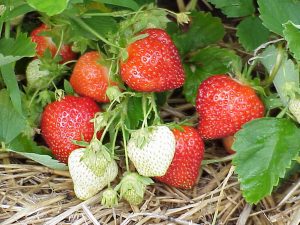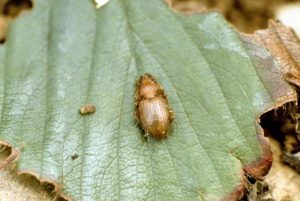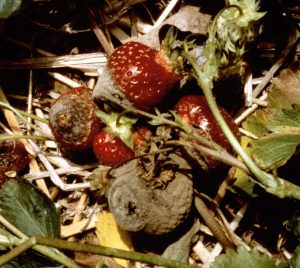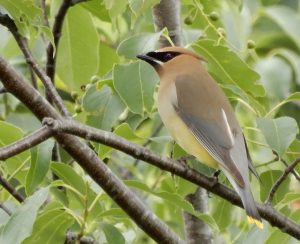Strawberry IPM Newsletter No. 4 – June 10, 2022

STRAWBERRY IPM NEWSLETTER No. 4 – June 10, 2022
“Click on photos to enlarge”
SOUTHERN MAINE GETS READY FOR HARVEST
Gray Mold a Concern with Recent Rains
Situation: Some ripe fruit are showing in southern Maine, and some spot picking is underway. Late varieties still have some bloom, although growers are reporting that the difference in ripening between early and later varieties seems to be compressed this spring. This is often the case when we have hot weather during fruit development and can be intensified by drought stress. Pest pressure continues to be fairly light, but growers should be ready to apply a fungicide for gray mold if you have not put one on since bloom or the field has received more than one inch of rain since your last application.
Two-spotted spider mites: Mite populations remain fairly low, perhaps due to some cooler, wetter weather and the presence of predatory mites. However, warm, dry weather can allow mites to build up rapidly, so growers should continue scouting for mites right up to harvest.
Tarnished plant bug remains very low, but growers should continue to scout for the active, yellow-green nymphs through petal fall to prevent injury on later ripening fruit. It is important to scout often, as they may appear very quickly in warm, dry weather. Insecticide options for tarnished plant bugs include malathion, Assail®, Brigade®, Bifenture®, Dibrom®, Danitol®, and PyGanic®.

Black vine weevil & strawberry root weevil: As we approach the harvest season remember that this is the time when adult black vine weevils and strawberry root weevils to begin to emerge and start feeding on strawberry foliage. Look for notching along the leaf edges and the presence of the black or brown snout beetles. The weevils feed mostly at night and spend the daylight hours at the base of the plants under the mulch. They will be laying eggs during the harvest and post-harvest period. The larvae or grubs feed on the strawberry plant roots through the fall, overwinter deep in the soil and feed again in the spring, causing plants to weaken and die. Badly infested beds should be plowed up as soon after harvest as possible. Bifenthrin (Brigade®) can be applied to kill the adults when they emerge and start to feed on the leaves (usually until mid-late July). Applications should be made at night when the insects are active, and the highest rate of the insecticide should be used. Platinum® can be applied in the fall as a soil drench to control grubs before they go into the winter.
Spotted wing drosophila: There have been only a few captures of SWD in the Northeast so far this spring. Typically this does not become a problem in Maine until late summer, but it is a concern for day-neutral strawberries, fall raspberries, and blueberries. Occasionally they may appear in late ripening spring strawberries. Products that provide good control of drosophila on strawberries include Radiant®, Brigade®, Danitol®, malathion and Assail®. Keeping fields clean of over-ripe and rotten fruit will also help reduce the incidence of this insect. Using fine netting over a structure can prevent SWD infestation, but is costly and only effective if done correctly. Chris Callahan, an Agricultural Engineer at the University of Vermont has recently put together some great information on using netting for SWD management. You can find it on his web page here: https://blog.uvm.edu/cwcallah/author/cwcallah/.

Diseases: Growers with fields still in bloom should keep protecting blossoms from gray mold infection through the bloom stage. Two to three sprays of fungicide during bloom are typically required to provide good protection against this disease, especially if fields remain wet for extended periods of time.
Leaf spot and Leaf scorch have been seen in some fields over the past two weeks usually on the lower, older foliage. Purple spots on the leaves with white centers characterize leaf spot, while small, dark red spots indicate leaf scorch. Younger foliage may become infected and cause the plants to weaken if left untreated. Fungicides applied to manage gray mold may also provide control of leaf spots. Captan®, Luna Sensation®, Mervion®, and Pristine® have activity on both diseases.

Birds, especially cedar waxwings, will soon be moving into fields to feed on ripe fruit. Where wax wings are a problem, only keeping a near-constant presence in the field and eliminating roosting sites can reduce the damage. Some chemical repellents containing methyl anthranilate (e.g. Avian ControlÒ), are registered for use on strawberries. Although most scientific studies on these products have not found them to be very effective, some growers have claimed good results. Remember that songbirds are protected by law and should not be killed. However, permits may be issued for killing birds by the U.S. Fish and Wildlife Service if they receive a recommendation for such a permit from the Maine Wildlife Services Office (part of the USDA Animal and Plant Health Inspection Service) in Augusta, along with an application from the grower. There is a $50 fee for the application, and it may take over a month for the permit to be processed. However, the permit is good for one year, so if you have problems this season, you may consider applying for a permit this winter, which would allow you an option to kill birds, if necessary, next season. The Wildlife Damage Office has recommendations for managing birds in crops, and also has some control options available through their office. For more information on permits or bird control contact the office in Augusta at 207.629.5181. The office is located in the Capital West Business Center at 79 Leighton Road in Augusta.
PFAS: What to know and what to say
As the state and federal governments work on how best to manage the emerging PFAS situation on farms in Maine due to sludge spreading, and now pesticide ingredients, you should be ready to reply to customers enquiries about PFAS and your farm. First, get informed. Listed below are two resources for PFAS information as it pertains to Maine Farms, including the Cooperative Extension PFAS information page, and the latest issues of the Maine Tree Fruit Newsletter, in which Glen Koehler at the Pest Management Office has put together a lot of information on PFAS and pesticides that is very relevant to fruit and vegetable growers, and will help you develop a plan on how best to respond to enquiries from your customers.
2022-2023 New England Small Fruit Management Guides The latest edition of the Guide is available online. A printed version of the guide is now available through our office. The cost of the Guide is $25, including shipping. You can request a copy by sending a check made out to “Cooperative Extension” to the Highmoor Farm address below. Members of the Maine Vegetable & Small Fruit Growers Association will receive a copy as a benefit of membership.
You can get quick access to strawberry IPM information through the UMaine Highmoor Farm news blog or the UMaine Pest Management web page. If you have questions about the Newsletter, please give us a call at 207.933.2100 or send an e-mail message to me at:
Sincerely,
David T. Handley
Vegetable and Small Fruit Specialist
Highmoor Farm Pest Management Unit
P.O. Box 179 17 Godfrey Dr.
Monmouth, ME 04259 Orono, ME 04473
207.933.2100 1.800.287.0279
Where brand names or company names are used, it is for the reader’s information. No endorsement is implied nor is any discrimination intended against products with similar ingredients. Always consult product labels for rates, application instructions and safety precautions. Users of these producers assume all associated risks.
The University of Maine is an equal opportunity/affirmative action institution.
